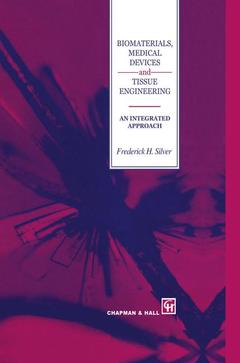Biomaterials, Medical Devices and Tissue Engineering: An Integrated Approach, Softcover reprint of the original 1st ed. 1994 An integrated approach
Langue : Anglais
Auteur : Silver F.H.

are then selected and must meet the general 'biocompatibility' require ments. Prototypes are built and tested to include biocompatibility evalua tions based on ASTM standard procedures. The device is validated for sterility and freedom from pyrogens before it can be tested on animals or humans. Medical devices are classified as class I, II or III depending on their invasiveness. Class I devices can be marketed by submitting notification to the FDA. Class II and III devices require either that they show equivalence to a device marketed prior to 1976 or that they receive pre-marketing approval. The time from device conception to FDA approval can range from months (class I device) to in excess of ten years (class III device). Therefore, much planning is necessary to pick the best regulatory approach. 2. Wound Dressings and Skin Replacement 2.1 Introduction Wounds to the skin are encountered every day. Minor skin wounds cause some pain, but these wounds will heal by themselves in time. Even though many minor wounds heal effectively without scarring in the absence of treatment, they heal more rapidly if they are kept clean and moist. Devices such as Band-Aids are used to assist in wound healing. For deeper wounds, a variety of wound dressings have been developed including cell cultured artificial skin. These materials are intended to promote healing of skin damaged or removed as a result of skin grafting, ulceration, burns, cancer excision or mechanical trauma.
1 Scope and markets for medical implants.- 1.1 Introduction.- 1.2 Markets for medical implants.- 1.3 Materials of construction.- 1.4 Pre-clinical and clinical biocompatibility evaluation.- 1.5 Biology of transplantation of tissue products matching.- 1.6 Federal Food and Drug Administration (FDA) regulations.- 1.7 Summary.- 2 Wound dressings and skin replacement.- 2.1 Introduction.- 2.2 Biochemistry of skin.- 2.3 Mechanical properties of skin.- 2.4 Repair of skin.- 2.5 Incidence of skin wounds.- 2.6 Wound dressings.- 2.7 Summary.- 3 Replacement of skeletal tissues.- 3.1 Introduction.- 3.2 Anatomy and physiology of tendons and ligaments.- 3.3 Biochemistry and biophysics.- 3.4 Mechanical properties of ligament.- 3.5 Repair of ligament.- 3.6 Clinical evaluation of ligament function.- 3.7 ACL reconstruction using biological and synthetic materials.- 3.8 Total joint replacement.- 3.9 Materials used in total knee replacement (TKR).- 3.10 Summary.- 4 Biomaterials used in ophthalmology.- 4.1 Introduction.- 4.2 Anatomy of the eye.- 4.3 Biochemistry of eye structures.- 4.4 Mechanical properties of ocular tissues.- 4.5 Corneal wound healing.- 4.6 Viscoelastic solutions.- 4.7 Intraocular lenses.- 4.8 Contact lens materials.- 4.9 Eye shields.- 4.10 Other ocular materials.- 4.11 Summary.- 5 Cardiovascular implants.- 5.1 Introduction.- 5.2 Physiology and anatomy of vessel wall and heart valve.- 5.3 Anatomy and physiology of blood components.- 5.4 Mechanical properties of aorta and valve.- 5.5 Repair of cardiovascular tissue.- 5.6 Pathophysiology of aortic and valvular diseases.- 5.7 Aorta and heart valve replacements.- 5.8 Cardiac valve replacements.- 5.9 Summary.- 6 Facial implants.- 6.1 Introduction.- 6.2 Biochemistry of facial tissues.- 6.3 Mechanical properties of facial tissues.-6.4 Repair of facial structures.- 6.5 Types of procedures performed in facial plastic surgery.- 6.6 Synthetic implant materials.- 6.7 Solid facial implants.- 6.8 Mesh materials.- 6.9 Summary.- 7 Dental implants.- 7.1 Introduction.- 7.2 Impression materials.- 7.3 Denture base resins.- 7.4 Restorative resins.- 7.5 Cements for restorations.- 7.6 Dental porcelains.- 7.7 Base metal alloys for dental castings.- 7.8 Other materials, collagen.- 7.9 Summary.- 8 Breast implants.- 8.1 Introduction.- 8.2 Anatomy and physiology of the breast.- 8.3 Psychology of breast augmentation.- 8.4 Types of breast implants.- 8.5 Complications associated with use of breast implants.- 8.6 Complications with poly(urethane)-covered implants.- 8.7 Implant placement.- 8.8 Current concerns.- 8.9 Summary.- 9 510 (k) and PMA regulatory filings in the US.- 9.1 Introduction.- 9.2 Components of a 510 (k) regulatory filing.- 9.3 Premarket approval (PMA) application.- References.
Date de parution : 09-2012
Ouvrage de 303 p.
15.5x23.5 cm
Thèmes de Biomaterials, Medical Devices and Tissue Engineering: An... :
Mots-clés :
Tissue Engineering; biomaterial; implant; medical devices; skin; tissue
© 2024 LAVOISIER S.A.S.



